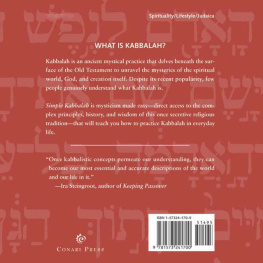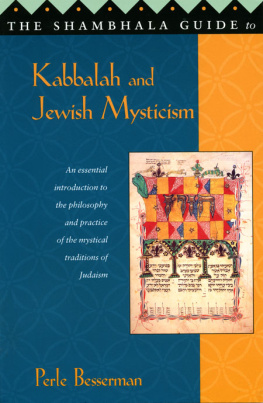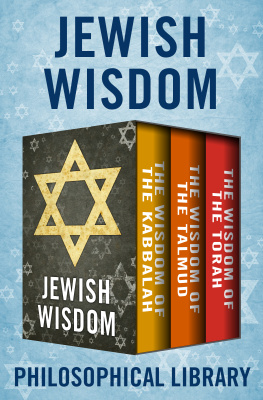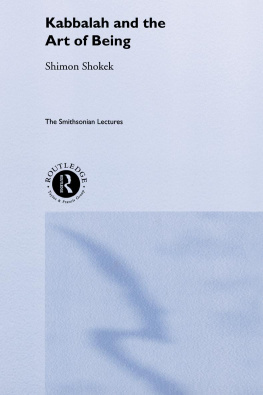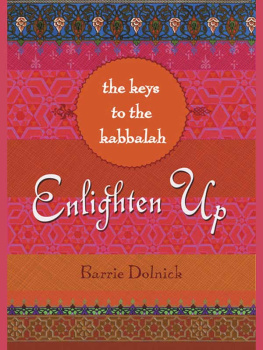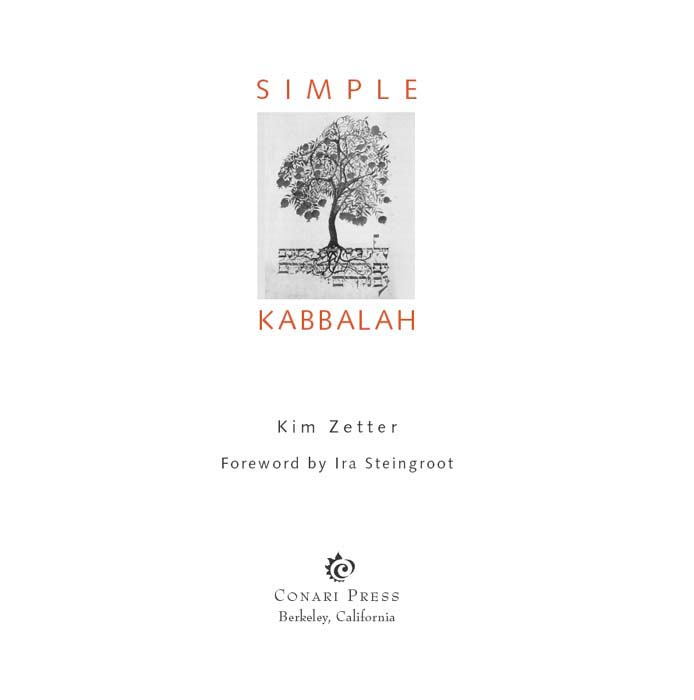
Copyright 1999 by Conari Press
All Rights Reserved. No part of this book may be used or reproduced in any manner whatsoever without written permission, except in the case of brief quotations in critical articles or reviews. For information, contact: Conari Press, 2550 Ninth Street, Suite 101, Berkeley, California 94710-2551.
Conari Press books are distributed by Publishers Group West.
Cover illustration: The Tree of Life, courtesy of the Judah L. Magnes Museum, Berkeley, CA
Cover and book design: Claudia Smelser
Library of Congress Cataloging-in-Publication Data
Zetter, Kim
Simple Kabbalah / Kim Zetter.
p. cm. (A simple wisdom book)
Includes bibliographical references.
ISBN: 1-57324-170-9
1. Cabala History and criticism. I. Title. II. Series.
BM 526 .Z47 1999
296.1'6 dc21
99-28435
CIP
Printed in the United States of America on recycled paper.
01 02 03 PHOENIX 10 9 8 7 6 5 4 3 2
For My Parents, with Love and Gratitude
SIMPLE KABBALAH
LIST OF ILLUSTRATIONS
2. Tree of Life Showing the Four Worlds and the English Names of the Sefirot
3. Tree of Life Showing the Twenty-two Letters of the Hebrew Alphabet in their Corresponding Paths
4. Tree of Life Showing the Ten Sefirot and the Corresponding Event in Creation
5. Tree of Life Showing the Sefirot, the Twenty-two Paths, and the Four Worlds
6. Tree of Life Showing the Four Worlds and the Qualities of Each Sefira
Table of the Sefirot
FOREWORD
by Ira Steingroot
Where was it one first heard of the truth? The the.
Wallace Stevens
About halfway through its two-thousand-year history, the course of Jewish mysticism led to the twelfth-century Provenal school of Isaac the Blind, also named, by paradox, rich in light. Here it assigned itself the name kabbalah, meaning received tradition. My own path to Kabbalah began in 1964, when I first read the mystical nature poetry of Isaac's contemporary, Francis of Assisi. I wondered if such an experience existed in Jewish tradition. I remembered the little I had been told about Kabbalah in Hebrew school and Sunday school, and I remembered that line from Allen Ginsberg's epic poem, Howl:
who studied Plotinus Poe St. John of the Cross telepathy and bop kabbalah because the cosmos instinctively vibrated at their feet in Kansas .
Well, the cosmos was vibrating at my feet in Toledo, Ohio, and the Beats' fleeting references to their sources led me to Neoplatonism, Symbolism, mysticism, Western occultism, Charlie Parker, and Gershom Scholem's Major Trends in Jewish Mysticism. When my grandfather became aware of my interest, he began bringing me volumes of our synagogue's Soncino edition of the Zohar to read. Later he bought me Judah Ashlag's first translated works from the Research Centre of Kabbalah. I can recall one afternoon when I joined my grandfather, the Rabbi, and a group of aged men, each one older than the next, for a Zohar study session. They looked like the crew in Poe's Ms. Found in a Bottle. Unfortunately, the text was in the original Aramaic and the discussion was in Yiddish, so I learned almost nothing. Or did I?
My own study of Kabbalah coincided with my suspension of Jewish practice. Observance meant little to me at that time since it seemed to lack the mystical element. Two events occurred that changed my point of view. Professor Joseph Dan, holder of the Gershom Scholem Chair of Jewish Mysticism at Hebrew University, spent the 1977 academic year at UC Berkeley. I was present for all ten hours of his weekly classes for two semesters. My understanding of the texts of Kabbalah increased exponentially, but I still had no definitive answer about practice. At the same time, my son was born in 1978, and I had to make decisions about rites of passage.
I began to practice Judaism again by observing the Shabbat (Sabbath) and holidays and by giving my son a Jewish education and making sure he became bar mitzvah. Passover became the most important moment of the year, once I set myself the task of reacquiring the skills my grandparents brought to performing the seder (ritual meal). Out of this came the insight that normative Judaism was the same as mystical Judaism. It was the kavvanot (mystical intention) that transformed rite words in rote order, as Joyce puts it, into mystical actions and expressions. We did not have to ransack the world's mystical traditions for esoteric customs or practices. We already had them. We just had to understand the mystical meaning that inhered in them at this moment.
Now, in thirty-five years of studying it, that is not the only thing I have derived from Kabbalah. It has been the grounding for every intellectual study that I have undertaken, whether reading Blake or listening to Louis Armstrong or looking at Duchamp or understanding the symbolism of alchemy. To call these studies intellectual is to limit in scope what have become my supreme fictions, those things in which I ultimately believe. Kabbalah's importance goes beyond these, though, to include even everyday jokes and casual table talk. Although such things may seem trivial, once kabbalistic concepts permeate our understanding, they can become our most essential and accurate descriptions of the world and our life in it. It bestows a heightened importance upon even the most inconsequential or mundane parts of life:
even as the trees that whisper round a temple become soon dear as the temple's self
John Keats
Just so, the cracking of a walnut might remind us that King Solomon in the Song of Songs descended to the garden of nuts. In the Zohar, this leads to a comparison of the skull and brain with the shell and meat of the nut. Soon we are thinking about the first three sefirot (divine emanations) and the differences between appearance and reality. Once we have been introduced to kabbalistic modes of thought, can we ever again look at anything in this marvelous world without being reminded of an incredibly interwoven net of correspondences? There is a way to look at life as a vale of tears, a drab, dreary, depressing experience, or, alternatively, as a big, sarcastic joke. We all have these moods at times. Kabbalah is a hermetic way of thought that frees us from the either/or dichotomies of happy/sad, good/bad, Apollo/Dionysius. Here opposites are reconciled, and our passing emotions are put in perspective:
To me the meanest flower that blows can give thoughts that do often lie too deep for tears.
William Wordsworth
If this volume you now hold is your introduction to kabbalah, you have an exciting adventure before you. May you receive this tradition with all the power, insight, and surprise that are enfolded within it.
Ira Steingroot
28 Nisan 5759
one: WHAT IS KABBALAH?
THE CODED MESSAGE
W hat is Kabbalah? Nothing short of an answer to the questions of our universe and the ages. More specifically, Kabbalah is the mystical, esoteric side of Judaism that delves into a deeper understanding of the Hebrew Bible (or Old Testament) beyond its literal interpretation to provide us with information about the soul; the nature of God, Creation, and the spiritual world; and about our individual relationship to God and each other.
Kabbalah has received much attention in recent years, often in conjunction with the highly publicized spiritual journeys of celebrities or in magazine articles about hot topics and trendy movements. But despite the bantering about Kabbalah at cocktail parties and on talk shows, not many people know what it is.
Next page
